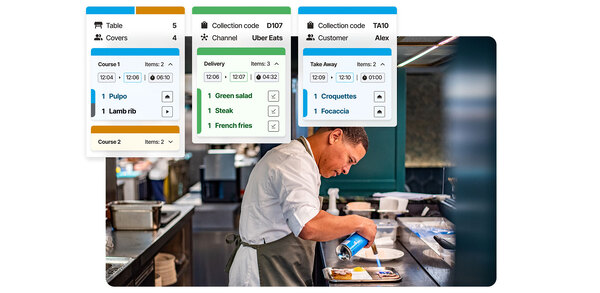Spotlight on: workforce management technology
Investing in workforce management technology could see swift returns in the current people-first climate. Rosalind Mullen looks at how to make staffing more efficient
With all the challenges that the past few years have thrown at the hospitality industry, employers might balk at investing in a workforce management (WFM) software, but many argue that in the current market they should.
WFM is even more compelling after all the advancements of recent years, such as Access’s Rotaready self-onboarding, Bizimply’s E-signature app and Quinyx’s Advanced Analytics (see panels). Essentially, WFM allows you to integrate sales forecasting within operational processes. It simplifies the complex tasks of staff scheduling and tracking attendance, reduces payroll errors, improves team communication, aids budgeting and forecasts demand. Its beauty is that it can reduce labour costs associated with overstaffing and free up time to focus on service and improve productivity, all while boosting the bottom line and employee retention.
“A solution to help match the right number of employees on each shift to meet the potential demands from guests has got to be worth serious consideration. With teams already being stretched to the limit with reduced headcount, optimising staffing levels seems an obvious, quick win,” says Jane Pendlebury, chief executive of HOSPA.
Case study: Bizimply at Daisy Green Collection
Founded Daisy Green was founded in 2012 by former investment banker Prue Freeman
Locations 13 restaurants in central London
The concept Every site has its own name and decor, but all share a relaxed Australian food and coffee culture and serve from breakfast to dinner to 1am

Founder Prue Freeman implemented Bizimply All-In-One WFM in 2018, having met founder Gerard Forde at a trade show. “[He] knew the catering and hospitality business inside out… and could talk about all the challenges involved in staff management and running an efficient business,” says Freeman, who clinched the deal after a trial demo.
Bizimply’s chief executive Conor Shaw describes the benefits of the software as enhancing the way shift-oriented operators manage their business, “optimising the entire people journey”. He adds: “Functionalities include employee scheduling, time and attendance, payroll and shift reporting across multiple locations, combining all the day-to-day management requirements of businesses into one easy-to-use cloud-based system.”
It’s now an integral part of the restaurant group, as operations manager Victoria Hardy explains: “People come to Daisy Green restaurants to relax and have a good time, but they are often working on a tight schedule, so, it is important for us to be on top of things while maintaining the casual, laid-back ambience. Daisy Green has to be a fun place to work if it is going to be a fun place to eat.”
The restaurants use all of Bizimply’s main rostering and time-management features. “I particularly like the fact that if staff members need to work in a different restaurant, their hours are still recorded automatically on the one system,” says Hardy.“It’s great for staff, too, as they can all see where and when they are needed at an instant on their mobile devices.”
Another benefit, she says, is that Bizimply gives her and the team an instant view of how business is doing on sales by restaurant and labour hours and helps her to forecast upcoming needs. And direct connection to the payroll system ensures staff get paid for every minute they work, on time, every time, “which is obviously vital for staff morale,” says Hardy.
It’s a strong partnership. The Daisy Green team meet with Bizimply a couple of times a year to discuss what WFM features they’d like. For example, Daisy Green has been influential in driving improvements in Bizimply timecards.
Sponsored viewpoint: Technology will help hospitality thrive
Conor Shaw, chief executive, Bizimply

Staff shortages continue to be the biggest challenge to hospitality’s ambitions to recover the ground lost during Covid and become the thriving and vibrant sector that everyone who works in it knows it can be. According to a survey conducted in January this year among Bizimply’s hospitality customers, 30% are expecting no improvement in recruitment of front of house staff this year, rising to 60% for kitchen staff.
Operators across the sector and a number of industry groups are of course looking at ways of unlocking the staffing challenge. Remuneration is one part of the solution, but not the only one: staff want to feel valued more broadly. They expect their employer to provide a rewarding job with good working conditions, training and career development, as well as respecting their life outside work.
Of course, this is easier said than done, and if you’re trying to run your business with a 10% vacancy rate, it’s hard enough to find enough staff to fill your shift, let alone deliver training or consider your team members’ work-life balance. It’s also true that historically, hospitality businesses haven’t always invested in training, because so many team members have been transitory.
Now though, operators are rethinking their approach to staff recruitment and retention and realising that investment in their team members makes more sense than ever. Create the right work environment and your business will be the one that people want to join, and then stay with. What could be better?
Many operators are now adopting workforce management solutions such as Bizimply, as a way of improving the workplace experience. By cutting the amount of time managers and supervisors spend on tasks like creating staff rotas and payroll, you create more time for them to spend where they can add most value – front of house, managing their teams.
This way, staff receive the coaching and motivation that improves their job satisfaction, meaning they are more likely to stay. Automating rotas also means staff get them earlier, giving them more notice of their shifts, and they can easily log their other commitments, such as childcare or studies, to avoid clashes. Integration with payroll means that wages are paid quickly and accurately.
In addition, Bizimply helps employers to manage their staff training and development by keeping details of courses attended and qualifications achieved in one place, logging any training needs identified, creating alerts for training updates and similar.
Hospitality is and always will be a people business and good technology will help keep it that way, freeing up talented people at every level to do the job they love, interacting with customers and delivering exceptional service.
Tech update

WFM technology is constantly being refined. Since 2021, for instance, Bizimply has updated its WFM offer, launching an E-Signature app that allows employees to digitally sign documents sent through by management, reinforcing paperless working and streamlining the onboarding of new recruits. It has also launched a Timestation Announcement feature, allowing managers to customise employee communications.
In 2022, Quinyx upgraded its WFM technology with the launch of its Advanced Analytics product. This provides more advanced levels of data, all in one place, with more detail regarding compliance, which helps organisations operating in different locations to identify any potential non-compliance risks. It takes into account local employment laws, scheduling rules, and employees’ preferences, helping businesses provide more flexibility to their workforce.
“We use our AI engine to produce compliance reports that check both historical compliance and future compliance and highlight any breaches – this means the business can take action before the employee works any shift that may have otherwise breached a compliance rule,” says Sammy Walton, head of product evangelism at Quinyx.
The comprehensive compliance analytics are complemented by a 360-degree data dashboard, optimisation analytics and engagement analytics. For example, quick Pulse surveys can gauge employee opinion on a particular issue.
Case study: Access Hospitality’s Rotaready in Brucan Pubs
Founded by Culinary duo James Lyon-Shaw and Jamie Dobbin, who opened their first pub in Windsor in 2018
Locations Four pubs in the south east
The concept Pubs offering good service and seasonal menus
Employees 124
Results of using WFM 688% ROI and 21 hours better deployed every week

At the start, all operational processes at Brucan Pubs were manual, including the use of spreadsheets to build staff rotas.
But as the group grew, it was clear it needed to take a leap into the digital age.
“We had employees moving between sites and data in three or four places, so bringing it all into one piece of software was key,” says HR and recruitment partner Nick Solomides. “We wanted to streamline every step of the employee journey, reduce the amount of paper we used, and the number of clicks managers had to do.”
In early 2022, the Brucan Pubs team identified Rotaready as the WFM solution that met their criteria of being cost effective and having good functionality without being robotic. All sites were up and running with Rotaready within a couple of weeks, which included an integration with Brucan’s Epos and reservation systems.
“Implementing Rotaready was straightforward – everything was done remotely with all of our historical data accurately imported. Generally, Rotaready is an easy and intuitive bit of software to use. Even the less computer-savvy were quickly brought up to speed,” says Solomides.
The technology also made the recent opening of Brucan Pubs fourth site in Finchampstead, much smoother.
“When you open a new pub there are enough stresses without having to worry about the admin. Rotaready enabled me to do what I needed to in an hour rather than a day,” says Solomides.
Besides being able to build accurate staff rotas, he says Rotaready has brought other benefits, too, including: enhanced visibility of rotas and costs across sites, allowing head office to see the bigger picture; extensive reporting, and improved payroll accuracy as time-sheet data feeds directly from Rotaready into Brucan’s payroll solution and effortless employee onboarding with all employees set-up correctly from day one. The team has also recently switched on one of Rotaready’s newest features, self-onboarding, which allows new recruits to submit their details directly via the app. This has removed the need for paper forms, improved data security and eliminated the risk of human error when translating information from paper into Rotaready.
The Brucan team are also about to tap into another Rotaready feature that will automatically issue contracts to new employees and then store them, further reducing the number of processes.
“I know it’s not going to take me half a day to get a new employee set up,” says Solomides. “Ten clicks are now two clicks. It saves us time which saves us money and head space.”
A combination of all these factors has helped Brucan Pubs see 21 hours better deployed every week and an ROI of 688%.
Case study: Quinyx in Roadchef
Concept One of Britain’s leading roadside service area operators hosting several brands, including McDonald’s, WHSmith, Costa Coffee and Leon
Locations 30 across the country
Results 95% forecasting accuracy
Roadchef has a big headache when it comes to forecasting and workforce planning, as operations planning manager Iain Thomson explains: “At a Roadchef site, customers have a number of brands and franchises to choose between. From McDonald’s to Costa Coffee and Leon to WHSmith, every brand has its own operating methods and focus on what to deliver. Thus, every brand needs a different approach to forecasting and scheduling.”
Quinyx understood that Roadchef was not a standard business and that a one-size-fits-all solution wouldn’t work. Using its hyper-local forecasting functionality, Roadchef is able to configure all key labour rules and labour metrics that are different across the brands.
“Doing this allows us to make very accurate sales, transactions, and labour deployment forecasts for each individual business down to 15-minute intervals,” says Thomson.
Since partnering with Quinyx, Roadchef has reported 95% forecasting accuracy, and improved supply and demand fit.
A recent study from Forrester Consulting reveals Quinyx delivered a 50% reduction in overtime costs to businesses surveyed over a three-year period – showing the impact of smarter scheduling.
It has also led to happier employees, says Thomson: “We can make schedules that incorporate certain wishes and still meet demand. One example is that we’ve been able to offer shorter and longer shifts than your typical seven- or eight-hour day in some areas, which allowed employees to combine their schedules with their lives in a much better way. The general feedback from employees has been hugely positive.”

















